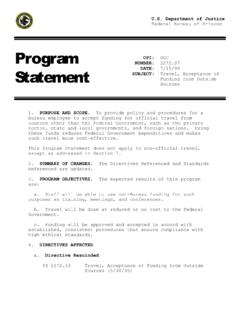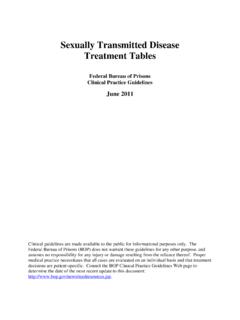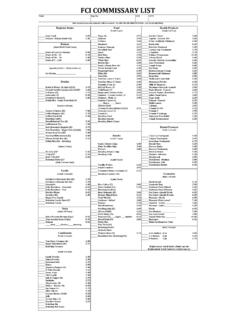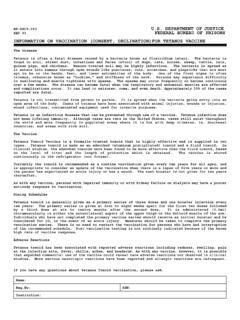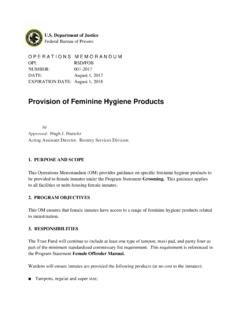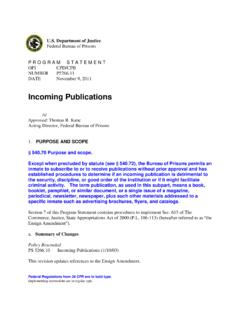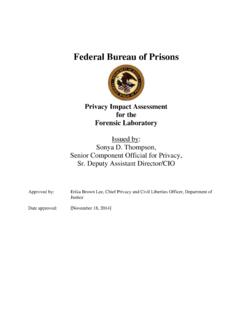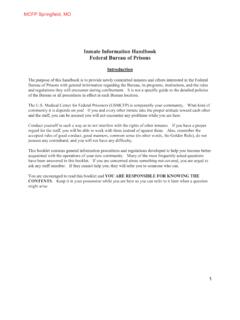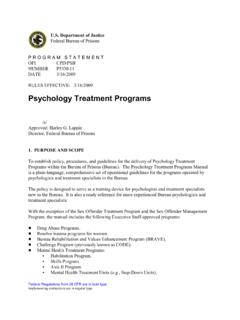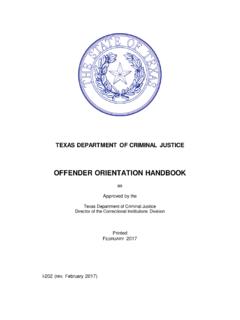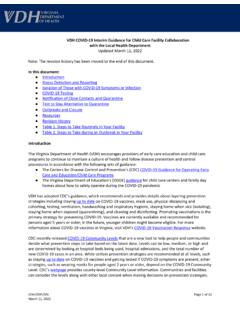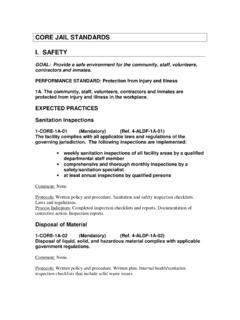Transcription of BOP: Racial Diversity of Correctional Workers and Inmates ...
1 Racial Diversity of Correctional Workers and Inmates : Organizational Commitment, Teamwork and Worker Efficacy in Prisons Scott D. Camp, , 1991, The Pennsylvania State University Social Science Research Analyst*. William G. Saylor, , 1977, University of Maryland Deputy Chief of the Office of Research and Evaluation*. Kevin N. Wright, , The Pennsylvania State University Professor and Head of the Division of Human Development**. *Office of Research and Evaluation Federal Bureau of Prisons 320 First Street, NW. 400 Building, Room 3025. Washington, DC 20534. 202-307-3871. **School of Education and Human Development, Binghamton University Binghamton, NY 13901. The opinions expressed in this paper represent those of the authors and do not necessarily reflect the position of either the Department of Justice or the Federal Bureau of Prisons. This paper will appear in the June 2001 issue of Justice Quarterly as a research note.
2 August 18, 2000. Racial Diversity of Correctional Workers and Inmates : Organizational Commitment, Teamwork and Worker Efficacy in Prisons Abstract Prior research into the effects of Racial Diversity upon workplace relationships has demonstrated that white Workers prefer to work in and with groups which are also comprised of white Workers . Using structural equation models, we tested whether higher levels of Racial Diversity , measured as social distance from coworkers and Inmates , were associated with lower evaluations of organizational commitment, teamwork among coworkers, and efficacy in dealing with Inmates . We found the expected negative effects of Racial Diversity upon white male Correctional Workers for organizational commitment, but not for teamwork and efficacy. For male minority Correctional Workers , Racial Diversity did not affect organizational commitment, teamwork, or efficacy.
3 Racial Diversity of Correctional Workers and Inmates : Organizational Commitment, Teamwork and Worker Efficacy in Prisons The riot at Attica in 1971 brought into sharp relief the issue of a predominantly white and rural staff supervising a prisoner population that was composed of a majority of black and Hispanic offenders from urban areas. Cultural differences and lack of understanding among the Correctional force were cited as primary grievances among rioting prisoners, and subsequent investigations confirmed that these issue were indeed a precipitating factor in the riot and a legitimate problem in the management of prisons (see Irwin 1980; Useem and Kimball 1991). Recognizing these issues, prison systems throughout the nation have sought over the past 30 years to increase representation of minority staff in the Correctional workforce. Convincing minority recruits to take positions in institutional corrections has not always proven easy.
4 Minority Workers have been reluctant to relocate in rural areas where prisons are often located in which there were few, if any, families of the same Racial or ethnic background. Prisons have had to compete for minority Workers with more lucrative, and perhaps more desirable, positions in private industry and other government service. Furthermore, some minority Workers have been unwilling to take positions in corrections which can be viewed as racist given the 1. overrepresentation of minority offenders in the criminal justice system. Despite the obstacles, prison systems have achieved considerable success in obtaining balance in Racial and ethnic representation within the workforce. Interestingly, even though this appears to be an important change in Correctional practice, researchers have paid virtually no attention to the impact of this change on either Correctional outcomes or organizational climates (for exceptions see Camp and Steiger 1995; Wright and Saylor 1992).
5 In this study, we are interested in the impact of the Racial Diversity within the prison workforce on individual Workers '. commitment to the organization, perceptions of teamwork among coworkers, and efficacy in working with Inmates . Obviously, from what happened at Attica and the subsequent realization of the importance of minority representation within the Correctional workforce, there are compelling reasons for increased Diversity . However, prior research has consistently discovered that heterogeneous work groups have lower levels of organizational commitment than homogenous groups (Mueller, Finley, Iverson, &. Price, 1999; Tsui, Egan, & O'Reilly, 1992). The implications of these findings pose an intriguing research question. What clearly poses as sound Correctional practice could have negative side effects on the prison work environment. In a Correctional agency, teamwork among Correctional officers is instrumental in operating 2.
6 A safe institution. Likewise, the ability to work with Inmates is crucial. It is important to understand whether or not increased Racial Diversity creates problems in feelings of teamwork among Correctional officers and their beliefs about their ability to work effectively with Inmates . We examined both the match between respondents with their coworkers and between respondents and the Inmates with whom they interact. In all studies to date, with the exception of Mueller et al. (1999), the reference group has been limited to that of coworkers. Mueller et al. examined whether the demographic composition of students had an impact upon teachers evaluations of their jobs. While they concluded that studies of occupations that require extensive interaction with clients should give consideration to the demographic composition of the clients, they found the strongest effect to be the demographic characteristics of the teachers themselves, the coworkers.
7 We also expect the effect for coworkers to be strongest in this study. PROPOSED MODEL. In place of formal hypotheses, Figures 1 and 2 provide schematic representations of the relationships we expected given the existing literature. The figures are simplified to emphasize the theoretically important relationships. Indicators from which the latent constructs were created, as designated by the latent construct names being enclosed within an oval, are not represented. The control variables are only indicated as being 3. part of a set of control variables entering each model. As can be seen in Figure 1, Racial Diversity was expected to have a negative impact upon perceptions of organizational commitment. In Figure 2, it can be seen that Racial Diversity was expected to have a direct negative effect upon efficacy as well as an indirect negative effect through teamwork. Racial Diversity was also expected to have a negative effect upon evaluations of teamwork.
8 As can be seen if Figure 2, this model is better elaborated than the model of institutional commitment as the latent construct of teamwork is treated as an intervening variable between Racial Diversity (and the control variables) and efficacy. {Figures 1 and 2 about here.}. It has been argued that active management of Racial Diversity in the workplace is necessary (Cox 1994; Cox and Blake 1991; Kramer 1991). Diversity training is one such technique that can help lower anxieties about working with coworkers who are of another race. As such, evaluations of the effectiveness of Diversity training were expected to have a positive impact upon evaluations of organizational commitment, teamwork, and efficacy (see Figures 1 and 2). DATA AND VARIABLES. We utilized two major sources of data. First, most of the data were taken from the results of the Prison Social Climate Survey (PSCS) that has been administered yearly by the Federal 4.
9 Bureau of Prisons (BOP) since 1988 to staff working at prisons of all security levels. We limited our analysis to data from 1996. Second, we used operational data that is captured in the Key Indicators/Strategic Support Decision information system to determine the numbers of staff and Inmates and their race at the 86 facilities for which we had survey data. The Key Indicators system is used to distribute monthly operational data to BOP. managers (Gilman 1991; Saylor 1988). The PSCS was distributed to 9,431 staff in 1996 working in 86 different prisons, and 8,387 staff returned usable surveys for a response rate of percent. Six of the prisons housed female Inmates , and the remainder housed males exclusively or primarily. Saylor (1984), in an early conceptual paper, described the topics surveyed by the PSCS. As noted there, the PSCS queries information about staff perceptions of the work environment at BOP prisons, the quality of life for Inmates at the respective prisons, the personal well-being of staff, the personal safety and security of staff and Inmates , and special interest sections to address current issues such as sexual harassment.
10 The PSCS. provides BOP management with feedback on operations at all prisons operated by the BOP. The survey data provided this analysis with information about perceptions of organizational commitment, teamwork, efficacy, and other individual-level characteristics. 5. We restricted our focus to responses from non-supervisory Correctional officers. We wanted to analyze members of a work group who performed the most similar functions on a daily basis to reduce unwanted sources of variation associated with job type. In a prison setting, the largest group of Workers who perform similar duties are Correctional officers. Additionally, the pool of respondents was further narrowed because the items we used to construct the measure of teamwork appeared in only two of four versions of the PSCS. The complete PSCS questionnaire is divided into sections based on the topic areas described previously.
